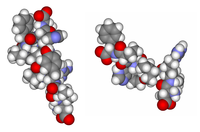
Photo from wikipedia
The classical renin-angiotensin system (RAS) in the body has been studied intensively in the last decades, since it is known that this system is involved in the regulation of blood… Click to show full abstract
The classical renin-angiotensin system (RAS) in the body has been studied intensively in the last decades, since it is known that this system is involved in the regulation of blood pressure. Since nearly all members of the classical RAS have also been identified within the brain in the last decades and due to the existence of the blood-brain barrier, a RAS within the brain (bRAS) that is largely independent from the peripheral RAS has been postulated. All members of the angiotensin family as e.g., angiotensin II, angiotensin IV and angiotensin II (1–7) along with the respective receptors (e.g., angiotensin II receptor type 1 (AT1), angiotensin II receptor type 2 (AT2), angiotensin IV receptor (AT4), angiotensin II (1–7) receptor (Mas)) have been identified within the brain. Moreover, a receptor capable of binding renin and the renin precursor prorenin with high affinity has also been detected within the brain. This protein functions as a membrane receptor for (pro)renin and also represents a V-ATPase subunit and is therefore termed (P)RR or Atp6ap2, respectively. In this review we shed light on the (known as well as putative) roles and functions of Atp6ap2 in the brain under physiological and pathophysiological conditions.
Journal Title: Neural Regeneration Research
Year Published: 2018
Link to full text (if available)
Share on Social Media: Sign Up to like & get
recommendations!